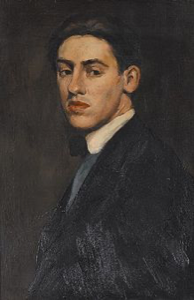Charles Demuth
American, (1883–1935)
Charles Demuth was an American artist best known for his luminous watercolors of flowers, figures, and architecture. A part of the Precisionist movement alongside Charles Sheeler and Gerald Murphy, Demuth employed vivid hues, exacting lines, and angular forms. In his hallmark work I Saw the Figure 5 in Gold (1928), Demuth visually transcribed William Carlos Williams’s poem The Great Figure (1921), through typography, gold leaf, and fire-engine red paint. “Paintings must be looked at and looked at and looked at,” he once said. “No writing, no talking, no singing, no dancing will explain them.” Born on November 8, 1883 in Lancaster, PA, he first experimented with watercolor while bedridden from an injury. Demuth went on to attend Franklin and Marshall College, Drexel University, and received his graduate degree from the Pennsylvania Academy of Fine Arts in Philadelphia. Having finished his education, he spent his time between New York, Paris, and Provincetown, MA, developing friendships with the playwright Eugene O’Neill, as well as Marcel Duchamp, Marsden Hartley, and Alfred Stieglitz. Suffering from early onset diabetes, Demuth returned to Lancaster in 1921 to undergo experimental treatments. The Metropolitan Museum of Art purchased one of his works in 1923, and he had a string of successful solo exhibitions over the following years. Demuth died on October 23, 1935 in Lancaster, PA, leaving much of his estate to his close friend Georgia O’Keeffe. Today, his works are held in the collections of the Art Institute of Chicago, the National Gallery of Art in Washington, D.C., the Whitney Museum of American Art in New York, and the Demuth Museum in Lancaster, among others.
Source: Artnet.com
American, (1883–1935)
Charles Demuth was an American artist best known for his luminous watercolors of flowers, figures, and architecture. A part of the Precisionist movement alongside Charles Sheeler and Gerald Murphy, Demuth employed vivid hues, exacting lines, and angular forms. In his hallmark work I Saw the Figure 5 in Gold (1928), Demuth visually transcribed William Carlos Williams’s poem The Great Figure (1921), through typography, gold leaf, and fire-engine red paint. “Paintings must be looked at and looked at and looked at,” he once said. “No writing, no talking, no singing, no dancing will explain them.” Born on November 8, 1883 in Lancaster, PA, he first experimented with watercolor while bedridden from an injury. Demuth went on to attend Franklin and Marshall College, Drexel University, and received his graduate degree from the Pennsylvania Academy of Fine Arts in Philadelphia. Having finished his education, he spent his time between New York, Paris, and Provincetown, MA, developing friendships with the playwright Eugene O’Neill, as well as Marcel Duchamp, Marsden Hartley, and Alfred Stieglitz. Suffering from early onset diabetes, Demuth returned to Lancaster in 1921 to undergo experimental treatments. The Metropolitan Museum of Art purchased one of his works in 1923, and he had a string of successful solo exhibitions over the following years. Demuth died on October 23, 1935 in Lancaster, PA, leaving much of his estate to his close friend Georgia O’Keeffe. Today, his works are held in the collections of the Art Institute of Chicago, the National Gallery of Art in Washington, D.C., the Whitney Museum of American Art in New York, and the Demuth Museum in Lancaster, among others.
Source: Artnet.com
Artist Objects
Sailors and Girl 1981.048
Three Figures on a Beach 1993.038



